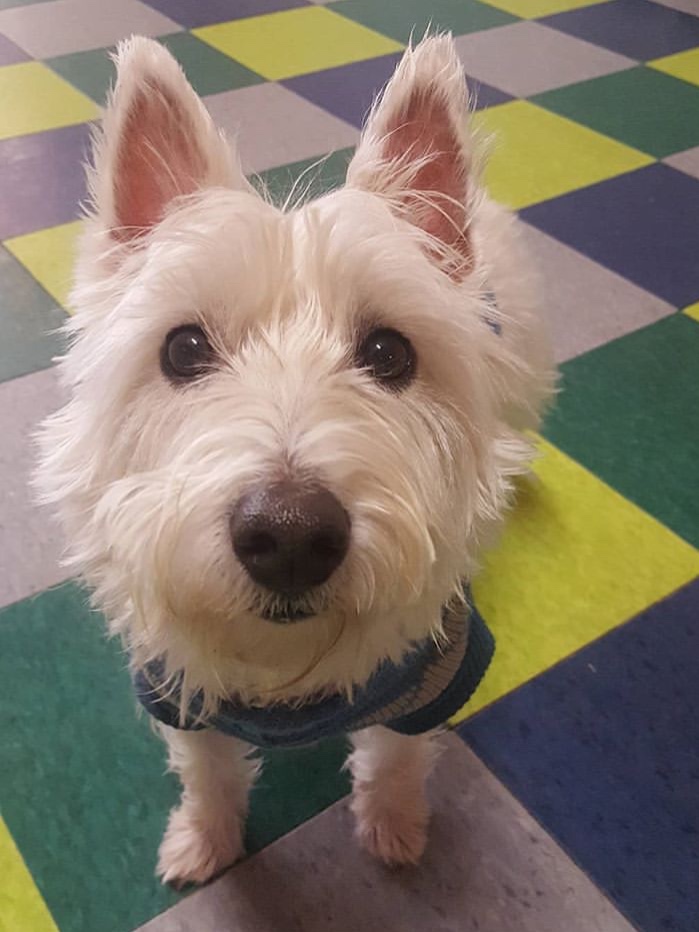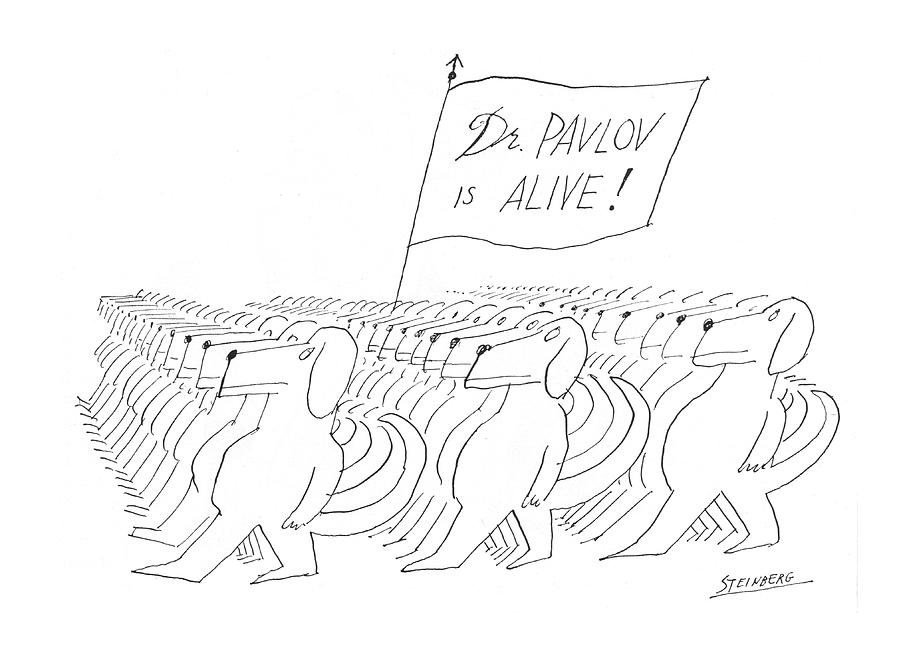
I recently read that dogs—through the imperatives of evolution—have developed expressions that invite positive interactions from their humans like “What a good boy” or a scratch behind the ears whenever, say, Wally looks me in the eye with a kind of urgency. There’s urgency all right, because he’s after something more than just my words or my touch.
The reward that he really wants comes after this hoped-for interaction. It’s a little squirt of oxytocin, a hormone and neuropeptide that strengthens bonding by making me, and then both of us together, feel good about our connection.
As you might expect, Wally looks at me a lot when I’m working and I almost always respond. How could anyone refuse that face? Besides, it gives whatever workspace I’m in a positive charge that can linger all day.

Social media has also learned that “likes”—or almost any kind of interaction by other people (or machines) with our pictures and posts—produces similar oxytocin squirts in those who are doing the posting. We’re not just putting something out there; we’re after something that’s both measureable and satisfying in return.
Of course, the caution light flashes when social media users begin to crave bursts of chemical approval like Wally does, or “to feel rejected” when the “likes” aren’t coming fast enough. It’s a feedback loop “of craving to approval” that keeps us coming back for more. Will they like us at least as much, and maybe more than they did the last time I was here? It’s the draw that always makes us stay on these social media platforms for longer than we want to and always keeps us coming back for more.
Social scientists have been telling us for years that craving approval for our contributions (along with not wanting to miss out) causes social media as well as cell-phone addiction in young people under 25. They are particularly susceptible to its lures because the pre-frontal cortex in their brains, the so-called seat of good judgment, is still developing. Of course, the ability to determine what’s good and bad for you is also underdeveloped in many older people too—I just never thought that included me.
So how I felt when I stopped my daily posting on Instagram three weeks ago came as a definite comeuppance. Until then I thought I had too much “good sense” to allow myself to be manipulated in these ways.
For the past 6 years, I’ve posted a photo on Instagram (or IG) almost every day. I told myself that regular picture-taking would make me look at the world more closely while, at the same time, making me better at capturing what I saw. It would give me a cache of visual memories about where I’d been and what I’d been doing, and posting on IG gave me a chance to share them with others.
In recent years, I’d regularly get around 50 “likes” for each photo along with upbeat comments from strangers in Yemen, Moscow and Beruit as well as from people I actually know. The volume and reach of approval wasn’t great by Rhianna standards, but as much as half of it would always come in the first few minutes after posting every day. I’d generally upload my images before getting out of bed in the morning, so for years now I’ve been starting my days with a series of “feel good” oxytocin bursts.
Of course, you know what happened next. My “cold turkey” from Instagram produced symptoms that felt exactly like withdrawal. It recalled the aftermath of cutting back on carbs a few years back or, after I was in the Coast Guard, nicotine. Noticeable. Physical. In the days that followed, I’d find myself repeatedly gazing over at my phone screen for notifications of likes or comments that were no longer coming. Or even worse, I’d explore identical-looking notifications for me to check other people’s pictures and stories, lures that felt like reminders of the boosts I was no longer getting. I felt “cut off” from something that had seemed both alive and necessary.
It’s one thing to read about social media or cell-phone addiction and accept it’s downsides as a mental exercise, quite another to feel withdrawal symptoms after quitting one of them.
Unlike the Food & Drug Administration, I did’t need anything more than my own clinical trial to tell me about the forces that were at play here, because at the same time that IG owner Mark Zuckerberg is engineering what feels like my addiction to his platform, he is also targeting me with ads for things (that I’m sorry to say) I realized I was wanting much more frequently. That’s because Instagram was learning all along what I was interested in whenever I hovered over one of its ads or followed an enticing link.
In other words, I’d been addicted to soften me up for buying stuff that IG had learned I’m likely to want in a retail exchange that effectively made both IG and Mark Zuckerberg the middleman in every sale. IG’s oxcytocin machine had turned me into a captive audience who’d been intentionally rendered susceptible to buying whatever IG was hawking.
That seems both manipulative and underhanded to me.
It’s one thing to write about “loss of autonomy” to the on-line tech giants, it is another to have felt a measure of that loss.
So where does this leave me, or any of us?
How do lawmakers and regulators limit (or prevent) subtle but nonetheless real chemical dependency when it’s induced by a tech platform?
Is breaking the ad-based business models that turn so many of us into captive buyers even possible in a market system that has used advertising to stoke sales for more than 200 years? Can our consumer-oriented economy turn its back on what may be the most effective sales model ever invented?
To think that we are grappling with either of these questions today would be an illusion.
The U.S. Federal Trade Commission has just fined Facebook (which is IG’s owner) for failing to implement and enforce narrow privacy policies that it had promised to implement and enforce years ago. The FTC also mandated oversight of Zuckerberg personally. Unlike the CEOs of other public companies, because he has effective ownership control of Facebook, his board of directors can’t really hold his feet to the fire. But neither the fine nor this new oversight mechanism challenge the company’s underlying business model, which is to (1) induce an oxytocin dependency in its users; (2) gather their personal data while they are feeling good by satisfying their cravings; (3) sell their personal data to advertisers; and (4) profit from the ads that are aimed at users who either don’t know or don’t care that they are being seduced in this way.
Recently announced antitrust investigations are also aimed at different problems. The Justice Department, FTC and Congress will be questioning the size of companies like Facebook and their dominance among competitors. One remedy might break Facebook into smaller pieces (like undoing it’s 2012 purchase of Instagram). However, these investigations are not about challenging a business model that induces dependency in its users, eavesdrops on their personal behavior both on-site and off of it, and then turns them into consumers of the products on its shelves. The best that can be hoped for is that some of these dominant platforms may be cut down to size and have some of their anti-competitive practices curtailed.
Even the data-privacy initiatives that some are proposing are unlikely to change this business model. Their most likely result is that users who want to restrict access to, and use of, their personal information will have to pay for the privilege of utilizing Facebook or Google or migrate to new privacy-protecting platforms that will be coming on-line. I profiled one of them, called Solid, on this page a few weeks back.
Since it looks like we’ll be stuck in this brave new world for awhile, why does it matter that we’re being misused in this way?
Personal behavior has always been influenced by whatever “the Jones” were buying or doing next door (if you were desperate enough to keep up with them). In high school you changed what you were wearing or who you were hanging out with if you wanted to be seen as one of the cool kids. Realizing that your hero, James Bond, is wearing an Omega watch might make you want to buy one too. But the influence to buy or to imitate that I’m describing here with Instagram feels new, different and more invasive, like we’ve entered the realm of science fiction.
Social media companies like Facebook and Instagram are using psychological power, that we’ve more or less given them, to remove some of the freedom in our choices so that they, in turn, can make Midas kingdoms of money off of us. And perhaps their best trick of all is that you only feel the ache of dependency that kept you in their rabbit holes—and how they conditioned you to respond once you were in them—after you decide to leave.

Maybe the scariest part of this was my knowing better, but acquiescing anyway, for all of those years.
It’s particularly alarming given my belief that autonomy (along with generosity) are the most important qualities that I have.
I guess I had to feel what had happened to me in order to understand the subtlety of my addiction, the loss of freedom that my cravings for connection had induced, and my susceptibility to being used, against my will, by strangers for their own, very different purposes.
By delivering “warm and fuzzies” every day and getting me to stay for their commercials, Instagram became my small experience of mind control and Big Brother.
Over the past few weeks, I see people looking for something in their phones and think differently about what they’re doing. That’s because I still feel some of the need for what they may be looking for too.
It gives a whole new meaning to “the dog days” this summer.
+ + +
I’d love to hear from you if you’ve had a similar experience with a social network like Facebook or Instagram. If we don’t end up talking before then, I’ll see you next week.
This post was adapted from my July 28, 2019 newsletter. When you subscribe, a new newsletter/post will be delivered to your inbox every Sunday morning.
Leave a Reply